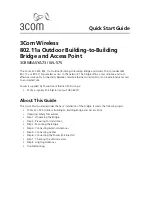
166
167
166
Glossary
802.11b
IEEE 802.11b
(
IEEE Std. 802.11b-1999
) is an enhancement of the initial
802.11 PHY
to include
5.5 Mbps and 11 Mbps data rates. It uses direct sequence spread spectrum (DSSS) or frequency
hopping spread spectrum (FHSS) in the 2.4 GHz ISM band as well as complementary code keying
(CCK) to provide the higher data rates. It supports data rates ranging from 1 to 11 Mbps.
802.11e
IEEE 802.11e
is a developing
IEEE
standard for
MAC
enhancements to support
QoS
. It provides
a mechanism to prioritize traffic within
802.11
. It defines allowed changes in the Arbitration
Interframe Space, a minimum and maximum Contention Window size, and the maximum length
(in kµsec) of a burst of data.
IEEE
802.11e is still a draft
IEEE
standard (most recent version is D5.0, July 2003). A currently
available subset of 802.11e is the
Wireless Multimedia Enhancements
(
WME
) standard.
802.11f
IEEE
802.11f (
IEEE Std. 802.11f-2003
) is a standard that defines the inter access point protocol
(
IAPP
) for access points (wireless hubs) in an extended service set (
ESS
). The standard defines
how access points communicate the associations and reassociations of their mobile stations.
802.11g
IEEE 802.11g
(
IEEE Std. 802.11g-2003
) is a higher speed extension (up to 54 Mbps) to the
802.11b
PHY
, while operating in the 2.4 GHz band. It uses orthogonal frequency division multiplexing
(OFDM). It supports data rates ranging from 1 to 54 Mbps.
802.11i
IEEE 802.11i
is a developing
IEEE
standard for security in a wireless local area network (
WLAN
).
It defines enhancements to the
MAC
Layer to counter the some of the weaknesses of
WEP
.
802.11i will incorporate
802.1x
and stronger encryption techniques, such as Advanced Encryption
Standard (
AES
).
IEEE
802.11i is still a draft
IEEE
standard (most recent version is D5.0, August 2003). A
currently available subset of 802.11i is the
Wi-Fi
Protected Access
(
WPA
) standard.
802.1Q
IEEE 802.1Q
is the
IEEE
standard for
Virtual Local Area Networks
(
VLAN
s) specific to wireless
technologies. (See
http://www.ieee802.org/1/pages/802.1Q.html
.)
The standard addresses the problem of how to break large networks into smaller parts to prevent
broadcast and multicast data traffic from consuming more bandwidth than is necessary. 802.11Q
also provides for better security between segments of internal networks. The 802.1Q specification
provides a standard method for inserting VLAN membership information into Ethernet frames.
Access Point
An
access point
is the communication hub for the devices on a
WLAN
, providing a connection or
bridgebetween wireless and wired network devices. It supports a
Wireless Networking Framework
called
Infrastructure Mode
.
Содержание AirPremier DWL-2210AP
Страница 192: ...192 192 5 12 05 Registration Register your D Link product online at http support dlink com register ...
Страница 193: ...193 ...
















































